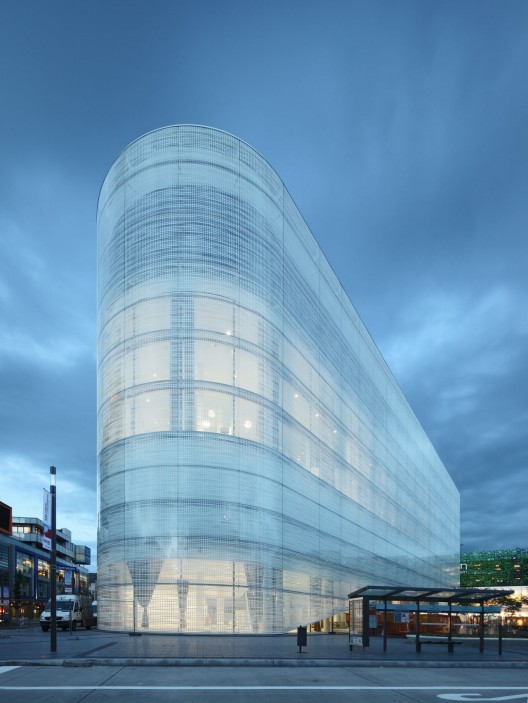 |
| Source: archdaily.com |
Kraanspoor, Amsterdam, The Netherlands, 2007 designed by OTH, Ontwerpgroep Trude Hooykaas bv
The newly built construction is characterized by its transparent double-skin climate façade of glass: the outer layer of moveable motor-driven glass louvers appear as lace-work around the building, the inner façade is of hinged timber windows with a full height from office floor to ceiling. This climate façade allows natural ventilation of the offices and acts as a buffer against heat in the summer and cold in the winter. --
ArchDaily
The scheme is characterised by a vast, double-skin glass facade which provides ample daylight for the internal spaces. The inner facade consists of full-height, hinged timber windows, while the outer ‘climate’ facade is articulated by motorised glass louvres. -- Architecture Today
 |
| Source: ennead.com |
William J. Clinton Presidential Center, Little Rock, Arkansas, USA, 2004 designed by Ennead Architects(Previously Polshek Partnership)
the main body of the Center is turned perpendicular to the river and elevated off the ground plane, allowing the new 30-acre city park along south bank of the Arkansas River to flow beneath. -- architect's web site
AIA/COTE Top Ten Green Projects
The project's outer west-facing wall of glass has a screened interlayer that blocks 50% of the sun's light and heat and 99% of the UV rays. The interior environment features demand-controlled ventilation and radiant-floor heating and cooling. Extensive daylighting, energy-efficient electric lighting, and a building-management system further improve the project's efficiency, and a 50-kilowatt photovoltaic array produces electricity on site. Materials were selected for their regional availability, recycled content, rapidly renewable content, and low chemical emissions.-- aiatopten.org
Clinton Library Goes Platinum --
Jetson Green
 |
| Source: Jasmin Schuller / Visual Entertainment archdaily.com |
Karmeliterhof, Karmeliterplatz, Graz, Austria, 2004 designed by LOVE architecture and urbanism
The ceiling-high window casements (mounted in front of the façade at a slight angle towards the plane of the façade) face the square and therefore reflect by turn the activities in the square, the surrounding building fronts or the sky in different refraction. Functionally speaking, the facade is a climate façade, a double-skin façade with a fixed glass front made of solar control glass and a circumferential frame that features ventilation openings at the bottom and on the sides. Sliding doors are mounted towards the interior and form the actual spatial enclosure. -- ArchDaily
 |
| Source: Javier Callejas Sevilla archdaily.com |
Zamora Offices, Zamora, Spain, 2012 designed by Alberto Campo Baeza
Within the stone box, a glass box, only glass. Like a greenhouse. With a double facade similar to a Trombe wall. The external skin of the facade is made of glass, each single sheet measuring 600x300x1,2 and all joined together simply with structural silicone and hardly anything else. As if entirely made of air. The trihedral upper angles of the box are made completely with glass, thus even further accentuating the effect of transparency. Precisely what Mies was looking for in his Friedrichstrasse tower. The trihedron built with air, a true Glass Corner. And engraved in acid on the glass: -- ArchDaily
 |
| Source: Thomas Eicken archdaily.com |
Kulturbau, Zentralplatz, Koblenz, Germany, 2013 designed by Benthem Crouwel Architects
The volume has a double facade with a Structural-Glazing construction of white silk-screened glass, which envelops the building like a second skin and offers a frosted and refined appearance. The motif of the print provides a filtered view from inside to outside, and allows a vaguely transparent view when looking from the outside in. At the different entrances, the outer facade has a spacious cut and therefore offers a direct view of the lobby and entrance areas. -- ArchDaily
 |
| Source: Stéphane Cuisset archdaily.com |
Community House of Lorient, Lorient, France, 2014 designed by Jean de Giacinto Architecture + Duncan Lewis Scape Architecture
This is a cuboid four facades adorned with different specifications
depending on their orientation but aesthetic uniformity. They split into
two skins creating a buffer space to enable the management of the flow
of air around the massif. --
ArchDaily






No comments:
Post a Comment